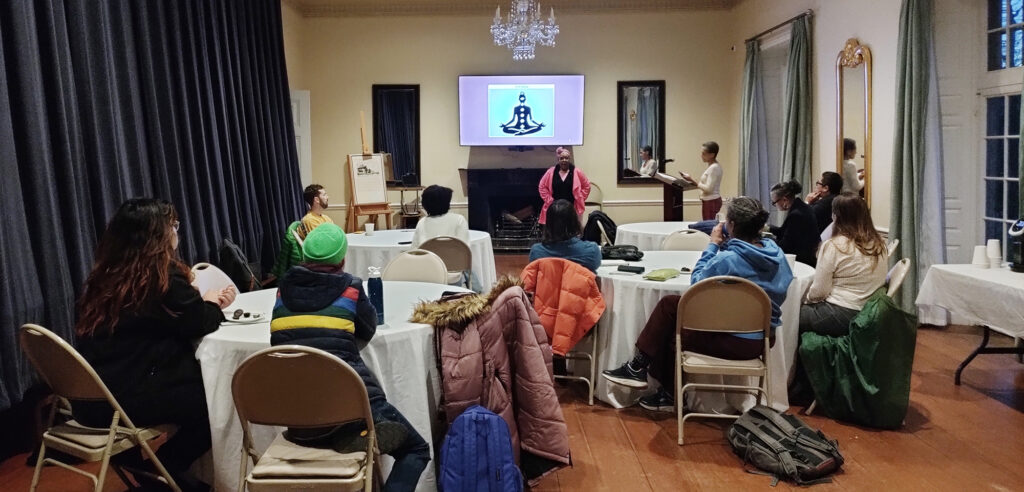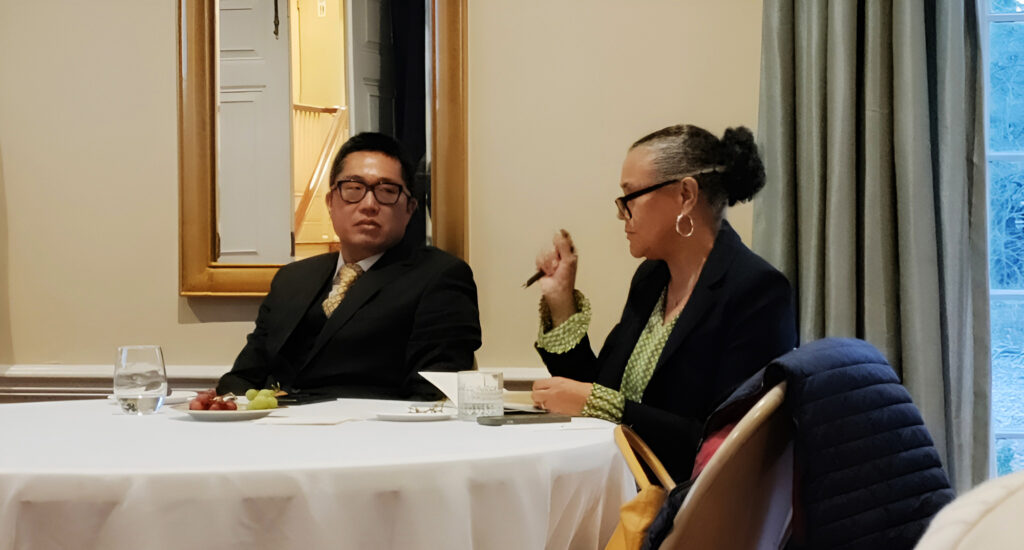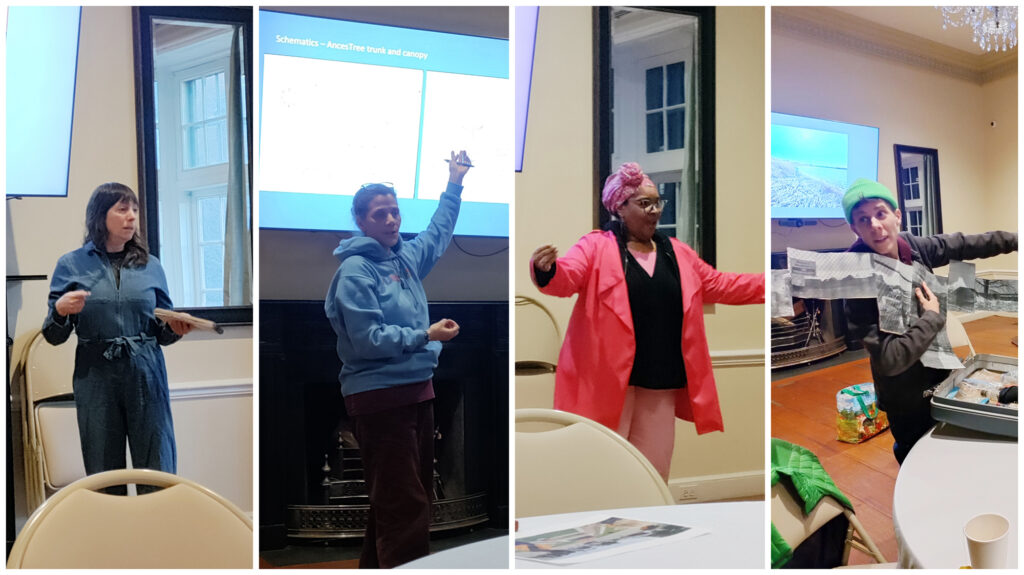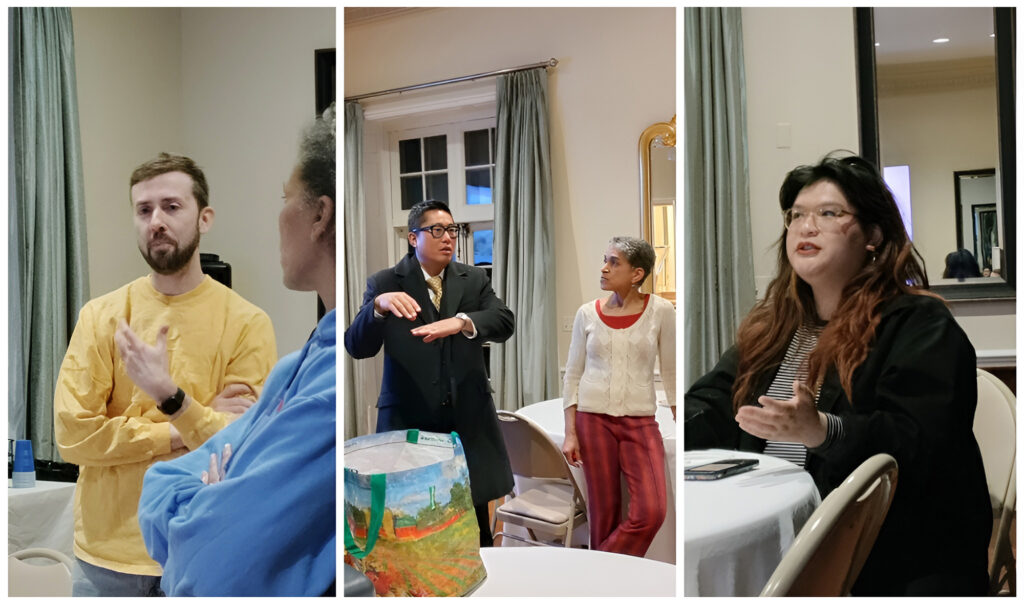PCL artists propose their final interventions
The Spring of 2025 has been bustling with PCL activities as our artists develop their final projects that will soon be seen and experienced across the city of Providence this summer. In preparation, the month of February saw some of the artists presenting their installation proposals for approval to the Special Committee for the Review of Commemorative Works, hosted by the City of Providence’s Department of Art, Culture and Tourism (ACT). Right on its heels, the Lab administrative team organized a critical workshop with Eric Sung and Dr. Renée Ater for the artists to receive feedback on their ideas. Read ahead to learn about each of these convenings and get a first look at the artists’ proposals.
February 11th: PCL Artists Lu Heintz, Sheida Soleimani, Valerie Tutson, Eli Nixon, Raffini and Linsey Wallace presented their physical installation proposals for their specific sites: Roger Williams Park, Public Street and the former Columbus Square. A Special Committee for the Review of Commemorative Works meeting was held at the Joseph A Doorley Jr. Municipal Building in Providence, Rhode Island. The Special Committee meets twice annually and is composed of scholars and experts in the fields of history, commemoration and community organizing. The current appointees include:
- Touba Ghadessi (Appointed by the City of Providence Art and City Life Commission; Provost, Rhode Island School of Design)
- April Brown (Appointed by the Providence City Council; Arts administrator, Langston Hughes Community Poetry Reading)
- Dr. Quenby O. Hughes (Appointed by ACT; Labor historian, Rhode Island College)
- Traci Picard (Appointed by the City of Providence Archives; Researcher, public historian)
- Tiffini Bowers (Appointed by Mayor Brett P. Smiley; Curator, Hay Library)
- Joe Wilson Jr. (Director, ACT) is non-voting ex officio
- Caleb Horton (City Archivist, City Archives) is non-voting ex officio
In the one and a half hour long meeting, each artist pitched their community engagement plans and preliminary designs for temporary installations at their respective sites. All proposals were received well and approved by the committee. Summations of the proposals for each site follow:

At the former Columbus Square, artist Lu Heintz will install “Pond Lands” to commemorate land and interspecies relational networks in the area surrounding Mashapaug Pond. This pond is the only one that has survived from an ecosystem of several ponds, known as the pond lands. “Land-based collective memory and experience of interspecies relationality still survives in many peoples’ memories, stories, families and practices, but these connections are displaced. ‘Pond Lands’ aims to visually reconnect Columbus Square to its adjacent lands, providing a sense of place and belonging,” said Heintz by way of providing context for her installation.
At the same site, Valerie Tutson proposes “The Storytelling Ancestree” to commemorate neighborhood ancestries and stories. Sharing her vision, Tutson remarked, “The idea of a tree came about more than once, as something to symbolize a gathering place for the community to come and share stories.”
On Public Street, Eli Nixon (and a team led by Fatema Maswood) will install a thatched shade structure at the watery end of the site. Titled, “Public Porch”, the work will commemorate the humanity and survival of current neighborhood residents, as well the plants, birds and human communities that once thrived in that area. This, as Nixon states, is a way of honoring the ancient organisms that existed before the petrochemical and scrap metal takeover of the urban coastline and the people who continue to need, and fight for, safe public right of ways to the Bay. “Once erected, [Public Porch] will create a space for sharing silence, songs, snacks, conversations and more,” observed Nixon.

At Roger Williams Park, Sheida Soleimani’s tentatively titled “A Memory Bird” will commemorate birds and non-human beings. Soleimani envisions a bird bath with birds cast in glass that will “bring attention to the deaths of the countless birds at the Park, and also provide an element of care for the existing birds.”
Raffini will be commemorating and honoring multi-generation women and their personal and collective experiences at the Park through her installation “I (eye) am Woman”. Raffini is designing a seating structure that will be a place for gatherings centered on the experiences of women; it will be installed during the summer months and will honor the forgotten women of Providence.
Finally, Linsey Wallace’s “Community Reflection” will commemorate the neighbors of Roger Williams Park. Talking about her work, Wallace said, “Often monumental acts and grand accomplishments get commemorated. ‘Community Reflection’ is an illustration that everyone is deserving of acknowledgment regardless of their place in the sociopolitical strata.”
At the same site, Valerie Tutson proposes “The Storytelling Ancestree” to commemorate neighborhood ancestries and stories. Sharing her vision, Tutson remarked, “The idea of a tree came about more than once, as something to symbolize a gathering place for the community to come and share stories.”
On Public Street, Eli Nixon (and a team led by Fatema Maswood) will install a thatched shade structure at the watery end of the site. Titled, “Public Porch”, the work will commemorate the humanity and survival of current neighborhood residents, as well the plants, birds and human communities that once thrived in that area. This, as Nixon states, is a way of honoring the ancient organisms that existed before the petrochemical and scrap metal takeover of the urban coastline and the people who continue to need, and fight for, safe public right of ways to the Bay. “Once erected, [Public Porch] will create a space for sharing silence, songs, snacks, conversations and more,” observed Nixon.

February 26th: Later in the month, the Rhode Island Historical Society (RIHS) hosted a more informal critical workshop for PCL artists with Eric Sung and Dr. Renée Ater.
Sung is a professor in the Department of Art and Art History at Providence College, as well as an artist scholar and cultural worker. His artworks have been showcased in internationally renowned exhibition venues and public spaces. He is currently a member of WARP Artist Collective and serves on the Board of Directors for Rhode Island Humanities (RIH) and the Society for Photographic Education (SPE).
Dr. Ater is a public scholar and art historian who works at the intersection of art and history, with research that focuses on monuments, race, national identity, and public space. She is a Visiting Associate Professor in the Department of Africana Studies at Brown University and Associate Professor Emerita in the Department of Art History and Archaeology at the University of Maryland.

The workshop was an opportunity for the PCL artists to present their in-process ideas and receive feedback from the group. The artists who presented at the event were Linsey Wallace, Valerie Tutson, Raffini and Eli Nixon. They shared everything from formal installation plans and sketches to community engagement strategies and archiving/storytelling ideas.
Wallace shared her ideas for the final participatory, performative installation she is developing at Roger Williams Park and discussed various creative strategies for engaging Park neighbors and inviting them to contribute to the final intervention.
Tutson showcased early plans and sketches for the installation piece she is developing for the former Columbus Square that is inspired by both the formal qualities and the metaphorical significance of trees. She said, “When talking to communities about what they’d like to commemorate, something that often came up was trees: How trees hold space, how they shade us, how they comfort us.”

Raffini shared her ongoing efforts to build spaces that can hold and celebrate women’s stories and memories across generations. In discussing the purpose of her work, she remarked, “I want younger people to hear older people’s stories, and older people to hear younger people’s stories. Because we’re too dismissive and arrogant today, and we don’t stop to individualize people the way we should.”
And finally, Eli Nixon from the Public Street cohort ended the evening with a lively bit of suitcase theater while explaining the sculptural installations and interactive activations they are planning for their site by the Providence River. With interventions designed to shed light on the dire realities of the river’s current ecosystem, they stated, “I’m grappling with how to invite people to something that’s still actively being poisoned, even while we’re activating it, even while we’re commemorating it.”
The artists who presented received feedback on various aspects of their proposed ideas, from ways to navigate form and structure, to suggestions for more lasting and engaged community involvement. Sung wrapped up the evening stating, “Art makes it very difficult to disagree with the things that matter. And sometimes when we have to deal with things that are dark, we need to combat that darkness with the beauty of art.”

These two events, one a public meeting and the other a private gathering, are great examples that demonstrate the nuts and bolts of how large scale public art projects and commemorative works come to life with the support of municipal agencies like ACT and nonprofit cultural partners like RIHS. Dr. Micah Salkind, Deputy Director of the City’s Department of Art, Culture and Tourism, says, “we are so lucky to have the experts and culture-bearers we do in the room for these moments in the iterative processes that artists are committing to. I am grateful to the Special Committee members for their service, and to our wider PCL community of scholars, writers, and other creatives who continue to come together to think about the big questions posed by our project.”
Collaborative review and feedback processes embedded in the PCL help the artists not only share and build off of one another’s work, but also support their engagement with members of the greater Providence community that are involved in various dimensions of cultural strategy across academia, government, historical preservation and more. Stay tuned to see these projects come alive this summer and experience how they transform the city’s cultural landscape!

